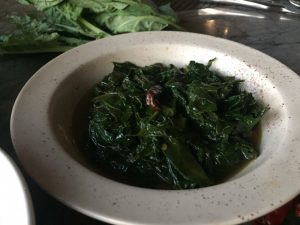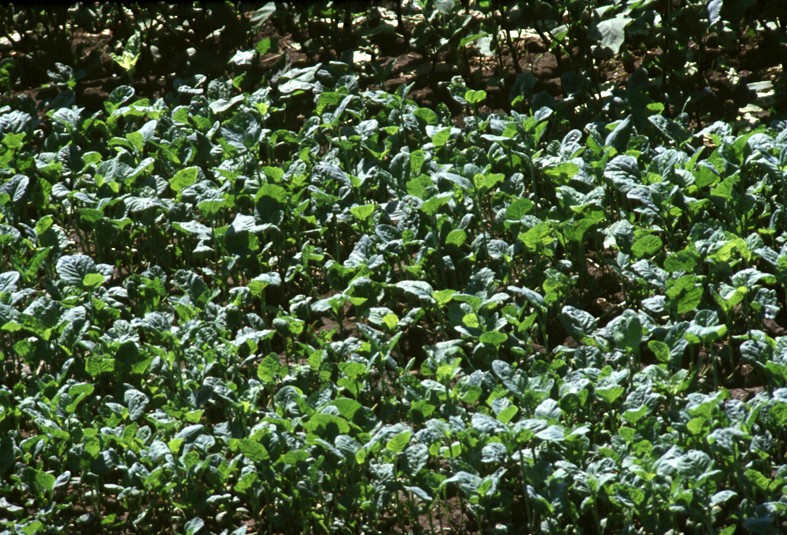Portuguese and Kashmiri, yet they have a common link: haakh.
Known as collard greens, this member of the vast brassica family has a distinct personality and an even more
 pronounced taste, with its trademark crinkly blue-green leaves along a central stem. Collard greens, along with its close cousin kale (both come under the sub-division acephala, under the broader classification brassica oleracea;
pronounced taste, with its trademark crinkly blue-green leaves along a central stem. Collard greens, along with its close cousin kale (both come under the sub-division acephala, under the broader classification brassica oleracea;
Food & Cooking, Harold McGee) grow extensively in parts of South America, Southern USA, Portugal and areas in Central Asia. In India, the only place that it makes an appearance is in Kashmir. Which has an almost mystical connection with Portugal. You see, both places have a soupy stew made of collard greens. In the case of Portugal, it is called caldo verdo; in Kashmir, a near identical stew is made of whole leaves simmered in water to which a touch of asafoetida and a whole chilli has been added. In both cases, it is the vegetable that is central to the dish. Caldo Verdo or ‘green soup’ is the national dish of Portugal in the same way that haakh is vital to the Kashmiri ethos.
If a Kashmiri wants to denote modesty, he will tell you that he is happy to live on “haakh-batha” or haakh and rice
for the rest of his life. And though it is grown plentifully in the Valley, it is not nearly as visible as it is in Northern Portugal, where it  literally shapes the landscape. In Kashmir, it is typically grown in individual land-holdings, many of which are surrounded by poplar trees, so the dominance of the vegetable is discerned more in vegetable markets and in the floating gardens of the Dal, where the trademark crinkly leaves show up in garden after garden.
literally shapes the landscape. In Kashmir, it is typically grown in individual land-holdings, many of which are surrounded by poplar trees, so the dominance of the vegetable is discerned more in vegetable markets and in the floating gardens of the Dal, where the trademark crinkly leaves show up in garden after garden.
Connoisseurs all over the city of Srinagar are clued in to where the vegetable grows best: in Kawdara, in the beating heart of the Old City. Other vegetables also grow in Kawdara, but none are as highly sought after as haakh. Householders will tell you that you should never buy haakh from a field that doesn’t get sunlight or where tobacco is grown. In the first case, the leaves will never cook, even with extended pressure cooking; in the second, the leaves will have an unpleasantly strong, bitter taste.
Says Dr. Pushpesh Pant, food historian, “Haakh is something of an acquired taste because of the underlying pungence.
 That is because it is from the brassica family, whose other members are cabbage, kale, broccoli, cauliflower, Brussels sprouts, kohlrabi, mustard, rocket, watercress, turnip and Chinese cabbage besides many others.” Pant points out that it is not quite accurate to compare spinach with haakh, because they do not belong to the same family. “The texture of the leaves is a giveaway,” he points out with accuracy. “Spinach is soft and wilts easily. Haakh on the other hand has a waxy surface and takes a far longer time to cook.” Indeed, one of the characteristics of haakh is the way that it remains coarse on the palate even after being cooked for extended periods, typically in a pressure cooker.
That is because it is from the brassica family, whose other members are cabbage, kale, broccoli, cauliflower, Brussels sprouts, kohlrabi, mustard, rocket, watercress, turnip and Chinese cabbage besides many others.” Pant points out that it is not quite accurate to compare spinach with haakh, because they do not belong to the same family. “The texture of the leaves is a giveaway,” he points out with accuracy. “Spinach is soft and wilts easily. Haakh on the other hand has a waxy surface and takes a far longer time to cook.” Indeed, one of the characteristics of haakh is the way that it remains coarse on the palate even after being cooked for extended periods, typically in a pressure cooker.
One wouldn’t have thought of haakh as being particularly versatile, but for the ingenuity of the Kashmiri cook, the same fellow who devised the multi-course wazwan that is unparalleled in the history of cuisine. Thus, we have the simplest method of cooking the leaves: just pick over, remove the tough, fibrous central stem, cook with a bit of mustard oil, plenty of water, a green chilli and either asafoetida or garlic  on an open fire till the leaves are tender. Cooking the haakh without a lid ensures that the colour is maintained.
on an open fire till the leaves are tender. Cooking the haakh without a lid ensures that the colour is maintained.
Haakh is also cooked variously with cottage cheese, dried fish, smoked fish and mutton. Depending on personal preference, the leaves can either be left intact or lightly broken up halfway through the cooking process with a wooden spoon. Occasionally, haakh is pounded (after being cooked and drained) in the limestone mortar and pestle that every family in Kashmir has. And up until three decades ago, haakh used to be dried and preserved for use in winter. However, those were the days when snowfall was so heavy as to make a trip to the market difficult.
One would have thought that it would have been impossible to grow haakh outside the Kashmir Valley, but that has
not been the case. With the exodus of Kashmiris to Delhi, there are certain markets where haakh is sold even by the
most modest of vegetable sellers, chiefly during the winter months. What is even more surprising is that the taste
is intact. In a blind tasting, it would be impossible for anyone to distinguish between a dish cooked with haakh
grown in Kashmir versus one made with haakh grown in Delhi.
Only one fact is certain: plain boiled haakh with nothing to mask the taste except a grain of asafoetida and a
pinch of salt is a treatment given to no other ingredient in Kashmir. And no other vegetable is cooked as many times
a week: that alone is proof of its popularity.
Courtesy by : mehreenhreshi


Comments are closed, but trackbacks and pingbacks are open.